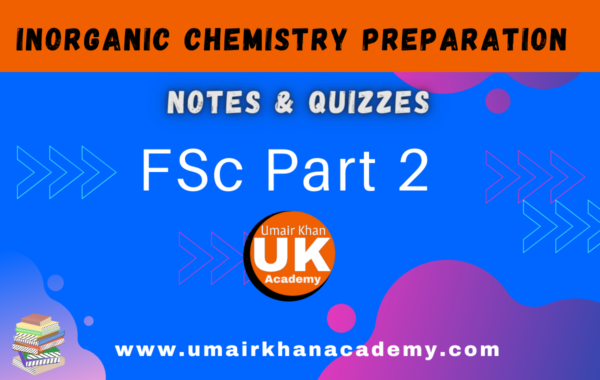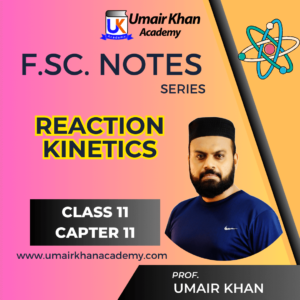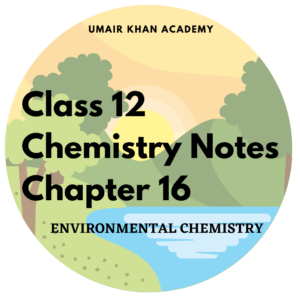Sometimes students of FSc part 2 chemistry feel difficulty preparing inorganic chemistry. Yes, it is hard to dominate but not impossible to learn. Therefore, here is a solution to prepare inorganic chemistry especially I’ll cover group III-A and IV-A elements with the help of Question answers and quizzes.
Attempt MCQ quiz 1 for group III-A elements below To main menu⏫
Attempt MCQ quiz 2 for group III-A elements below To main menu⏫
Attempt MCQ quiz 3 for group IV-A elements below To main menu⏫
Attempt MCQ quiz 4 for group IV-A elements below To main menu⏫
Group I-A and II-A elements are already covered in the previous post. for FSc class 12 Chemistry. You can also consult for class 12 chemistry topics on the Umair Khan Academy channel on youtube.
Questions-Answers and Notes for F.Sc. Part 2 Chemistry (Inorganic chemistry Group III-A and IV-A elements) To main menu⏫
Now it is time to take action, answers are so easy to understand just read and watch to learn it by heart. Answers are given in videos that are in Urdu/Hindi.
Q: why boron is non-metals?
Q: Boron 3+ ion doesn’t exist but Al 3+ ion does exist.
Q: Give the names and important formulas for minerals of boron.
Q: How borax is prepared from sodium carbonate?
Q: How does solubility of borax change with a change in temperature.
Q: How the temperature influences the water of crystallization of borax
Q: What is the action of an aqueous solution of borax on Litmus and why it’s aqueous solution is alkaline?
Q: Convert borax into boron nitride.
Q: What is the effect of heat on borax?
Q: How borax bead test is performed?
Q: What is the chemistry of the borax bead test?
Q: What is sodium silicate or water glass give its uses?
Q: What is the effect of heat on orthoboric acid?
Q: Why aluminium vessels are not washed with alkalies
Q: How aluminium becomes water-soluble by using sodium hydroxide?
Q: How Al is used to remove air bubbles from the molten metal?
Q: What is the utility of the reaction when aluminium reacts with oxygen?
Q: Why CO2 is gas and silicon dioxide is solid at room temperature?
Q: What are quartz give its properties.
Q: What is silica gel or fuse quartz?
Q: What is sodium silicate or water glass Give its uses.
Q: What is a chemical garden.
Q: Give the formula talc or soapstone give its properties and uses.
Q: What is Asbestos, give its uses.
Q: What is Asbestos, give its uses.
Q: What are silicones?
Q: Silicons are better lubricants as compared to petroleum oil why? OR what is the effect of temperature upon the viscosity of silicons?
Q: What Are Semiconductors.
Q: Why semiconductors are named so?
Q: How does Borax serves as a water softening agent.
Q: Why aluminium does not react with nitric acid.
Q: What is chrome yellow Give its use.
Q: Write down names and chemical formulas of two common minerals of carbon.
Q: What is the effect of temperature on semiconductors.
Q: Why conductivity of metals decreases by increasing temperature while the conductivity of semiconductors increases by increasing temperature?
2nd Year Chemistry Notes Chapter 3 Group III-A Elements (Extensive Questions outline) To main menu⏫
Q: Write few lines on Group III-A
(1) Elements of group III-A are consist of boron (B), aluminium (Al), gallium (Ga), indium (In) and thallium (TI). They have three electrons in the outermost shell. Two electrons are in the s-orbital and one unpaired electron in the p-orbital.
Q: Write general characteristics of elements of group III-A
(2) Their atomic sizes increase down the group.
(3) Melting and boiling points decrease down the group, but gallium shows abnormal behaviour. Ionization energies, electron affinities and electronegativities along with the heats of sublimation decrease down the group.
(4) B, Al and Ga show the oxidation states of +3, but indium and thallium also show the oxidation state of +1 due to the inert pair effect.
(5) Boron is a semi-metal and is close to the non-metallic character. Other elements of this group are metallic and good conductors of electricity.
(6) Elements of III-A form oxides of different natures. B₂O3 is acidic, Al₂O3 and Ga₂O3 are amphoteric, while In₂O3 and Tl₂O3 are basic in character.
(7) the elements react with halogens to form tri-halides with a general formula MX3 and they do not react with hydrogen directly. Anyhow, their hydrides are prepared indirectly.
Q: Write a short note on boron?
(8) Boron occurs in the combined state and is not an abundant element. It occurs in traces in most of the soil. The important minerals of boron are borax or tincal (Na2B4O7), colemanite (C2B6O11.5H2O) and Orthoboric acid (H3BO3).
(9) Boron differs from the other family members due to its extremely small and very high ionization energy
(10) Boron is non-metallic in nature. B+3 ion does not exist. It mostly gives covalent compounds and its oxides are acidic in character.
(11) Boron does not show the inert pair effect and has an ability to form the molecular addition compounds
Q: Write short note on borax.
(12) Borax can be prepared from orthoboric acid and colemanite, when they are separately treated with sodium carbonate Anyhow, natural Tincal (Na2B4O7.10H2O) when treated with water and a clear solution is evaporated, the crystals of borax are separated out.
(13) Borax is a white crystalline solid, increases its solubility with temperature and changes the number of water molecules of crystallization with the change in temperature.
(14) Above 62°C, pentahydrated borax is obtained. Below 62°C decahydrated crystals are obtained.
(15) The aqueous solution of borax is alkaline in nature and turns red litmus blue
(16) Borax reacts with HCl and H₂SO4 to give H3BO3.
(17) When borax is heated it swells up and a white porous mass is produced due to the expulsion of water molecules.
(18) Borax bead test is employed by using borax to check the presence of coloured ions like Cu2+ Fe2+, Mn2+, Co2+, Ni2+ and Cr3+. They give coloured beads in the oxidizing and reducing flames.
(19) Borax is used to prepare borate glass, in softening of water, in borax bead test, in metallurgical operations, as a flux in welding, in making washing powder, for the leather industry and for the manufacture of cosmetics, soaps. paints and medicines.
Q: Introduce Acids of Boron
(20) Boron gives four types of acids, which are orthoboric acid (H3BO3) metaboric acid, (HBO2) tetraboric acid (H₂B4O7) and pyroboric acids (HBO,). Meta and tetra boric acids are converted to orthoboric acids when reacted with water. Anyhow orthoboric acid can be prepared commercially from colemanite and borax.
(21) Orthoboric acid (H3BO3) is acidic in nature, but cannot be titrated with alkalies in a usual manner. But in the presence of glycerol, titration can be done by using phenolphthalein as an indicator
(22) Orthoboric acid (H3BO3) gives metaboric acid (HBO2) on heating and gives tetraboric acid (H2B4O7) on further heating. In the third stage of heating boric anhydride is produced.
(23) Boric acid reacts with sodium hydroxide (NaOH) and sodium carbonate (Na2CO3) to give borax (Na2B4O7).
(24) When boric acid (H3BO3) reacts with ethyl alcohol, it gives triethyl borate.
(25) Orthoboric acid (H3BO3) is used in medicine as an antiseptic in boric ointment and as eyewash. It finds its uses in pottery as a glaze and candle industry for stiffening of the wicks.
Q: Write occurrence reactions and uses of Aluminum
(26) Aluminum is found in the form of its minerals. It is a light metal with a density of 2.7 g cm, is malleable and ductile. It melts at 660°C. It is a good conductor of heat and electricity and is tarnished in the air.
(27) The reaction of aluminium with oxygen is highly exothermic and due to this property, it reduces the oxides of chromium, iron and manganese. The metals obtained from this reaction are in the molten state, hence this reaction can be used for welding.
(28) Aluminum reacts with dilute HCI and dilute H₂SO, to produce H, gas. It reacts with concentrated H₂SO, to give SO₂. Concentrated HNO, has no action on aluminum. Dilute nitric acid reacts very slowly with impure aluminum.
(29) Aluminum dissolves in alkalies with the evolution of hydrogen gas and soluble aluminates are produced.
(30) Aluminum is used as an electric conductor, for making aluminum alloys, for making utensils, frames and coils for motors and wires for electric transmissions. Aluminum powder is used in silver paints, for the extraction of chromium and manganese and as a de-oxidizer. Al is also used for preventing blowholes in the metallurgy of metals.
2nd Year Chemistry Notes Chapter 3 Group IV-A Elements (Extensive Questions outline) To main menu⏫
Q: What are the group IV-A elements, their properties and periodic trends?
(31) The elements of group IV-A are carbon (C), silicon (Si), germanium (Ge), tin (Sn) and lead (Pb). They have four electrons in the outermost shell. Two electrons are in the s-orbital and two in p sub-shell, while two electrons are unpaired.
(32) Their melting and boiling points go on decreasing from top to bottom. Anyhow, their atomic and ionic radii increase down the group.
(33) Their ionization energies, electron affinities, and electronegativities decrease down the group.
(34) They show the valencies of four, but tin (Sn) and lead (Pb) can show the valency of two as well due to the inert pair effect. The property of allotropy is associated with all these elements except lead.
(35) Metallic character increases down the group. Carbon and silicon are non-metals. Germanium is a metalloid while tin and lead are metals.
(36) All the elements of this group have the property of catenation. This property decreases down the group, while tin and lead hardly show this property.
(37) The general formula of hydrides is MH4.
(38) They react with oxygen to give mono-oxides or dioxides. The nature of dioxides changes from acidic to amphoteric and then to basic down the group.
(39) The general formula of halides is MX4. Anyhow, SnCl2 and PbCl2 are also common compounds.
(40) Carbon is widely distributed in nature in the forms of minerals as limestone, dolomite and magnesite. Anyhow, carbon is present in natural products closely associated with plants and animals. It is also present in carbohydrates, proteins, oils and fats.
(41) Silicon is a very abundant element and about 25% of the mass of the earth’s crust is due to this element.
(42) Silicon is not found free in nature, and it forms the major constituent of rocks in the form of silica and silicates.
Q: Detail notes on oxides of carbon and silicon
(43) The most important compound of silicon found in the earth’s crust is SiO2 and its various forms are rock crystal, amethyst quartz, smoky quartz, rose quartz and milky quartz. Actually, it is called sand. The hydrated variety of quartz is called opal.
(44) Carbon differs from its family members due to its very small size and maximum electronegative character. It is non-metallic in nature and shows the valency of four.
(45) It has an excellent property of catenation and is closely related to organic compounds.
(46) Carbon has three oxides as CO, CO₂ and C3O₂. In CO, two bonds are covalent and one is a coordinate covalent bond. CO is a polar molecule and its dipole moment is 0.112 D. CO acts as a good ligand. CO₂ is acidic in nature.
(47) CO₂ has a linear structure in which carbon is sp-hybridized and oxygen sp². The net dipole moment of CO₂ is zero and the solid CO₂, which is called dry ice, has a face-centred cubic structure.
(48) Silicon gives SiO₂ with oxygen, which is called silica. SiO₂ is transparent to light and can tolerate high temperatures. It has low thermal expansion. It is an excellent insulator. It is hard, brittle and elastic.
(49) SiO₂ is insoluble in water. It is not affected by acids and many other reagents. Anyhow, it reacts with HF.
(50) Quartz is one of the common crystalline forms of SiO₂. Quartz brittle, refractor and a colourless solid.
(51) SiO₂ differs from CO₂ in structure. SiO₂ has a giant network structure while CO₂ is a linear molecule and can exist independently.
(52) In SiO₂, every silicon and oxygen atom is sp3-hybridized, the bond angle is 109.5° and the whole chunk of silica is considered as one molecule.
Q: what are silicates, how they are produced and write uses?
(53) Silica glass, which is also called fused quartz, has a random structure. In the form of viscous liquid, it has a random structure as well. When this silica is cooled, it is not crystallized readily.
(54) Silicates are the derivatives of meta-silicic acid (H₂SiO3). Na₂SiO3 important silicate, which is also called water glass, or soluble glass soluble in water. Its aqueous solution is strongly alkaline. It is used in the preparation of a chemical garden.
(55) Sodium silicate is used as filler in soap manufacture, in textile proof, for furniture polish, in calico printing and as a preservative of eggs.
(56) Aluminum silicates are used to make porcelain and chinaware. They used to glaze the stoneware. Chinaware is made from a mixture of bone ash and feldspar.
(57) Talc or soapstone is another important silicate with the Mg3H₂(SiO3)4. It is greasy to touch and is used in making cosmetics some household articles.
(58) Asbestos is a mixed silicate of calcium and magnesium with the CaMg3(SiO3)4. It is used to make incombustible fabrics and hard boards.
Q: Write preparation, properties and uses of SILICONES
(59) Silicones are produced when dichloro dimethyl silicon is treated with water
(60) The lower silicones are oily liquids while higher members are waxy. They are stable towards heat and chemical reagents.
(61) The viscosity of silicon oils doesn’t change that much with temperature as compared to the petroleum oils.
(62) Silicone oils are used in high-temperature oil baths and high vacuum Silicon oils are used for low-temperature lubrication in making Vaseline like greases.
(63) Methyl silicones of high molar masses resemble rubber and are insulating materials for electrical motors. Silicones are used to cover the surfaces of plastics, asbestos, glass, leather, filter paper and blotting paper.
Q: What Are Semiconductors and Their Uses
(64) Germanium, selenium and silicon are important semiconductors. The electrical conductivity of semiconductors depends upon temperature.
(65) When a semiconductor is heated, its resistance decreases and conductivity increases. Similarly, when a semiconductor absorbs light, the electrons become mobile and conductivity increases.
(66) Uses: Semi-conductors are used in transistors, which are used in radio, T.V. computers and calculators.
Q: Detail Note on Lead Pigments
(67) Some of the compounds of lead are used as lead pigments.
(68) Pb2O is a black powder. PbO, which is called litharge or massicot and exists in two crystalline forms i.e. rhombic, which is yellow in colour and tetragonal, which is red in colour.
(69) When the litharge is boiled with water and olive oil, we get lead oleate. This is a sticky adhesive mass.
(70) Litharge is used in preparing flint glass and paints, for preparing oils and varnishes, for the manufacture of glazes, in the rubber industry and lead storage battery.
(71) Pb3O4 called the red lead, minium or Sindhu, is scarlet in colour. It becomes violet and black on heating but regains its original colour on cooling.
(72) Pb3O4 is used as a red pigment in paints, in the glass industry, in lead storage batteries, in the manufacture of flint glass, matches and ceramic glazes.
(73) PbO2 is a reddish-brown powder, less soluble in water and dissolves in alkaline water to give soluble plumbates.
(74) PbO₂ is used in the grids of lead plate accumulators, for the preparation of rubbing surface for safety matches and as an oxidizing agent.
(75) The formula of basic lead carbonate is 2PbCO3.Pb(OH)2. It is a white amorphous powder insoluble in water and highly poisonous.
(76) When white lead is mixed with linseed oil, it has a good covering power. It is poisonous in nature and when heated up to 43°C, it decomposes to give a red lead.
(77) Lead chromate (PbCrO4) also called chrome yellow is a yellow solid. It is the least soluble in the water among all the lead salts. (78) Lead chromate is used as a pigment under the name of chrome yellow. When it is mixed with lead sulphate or barium sulphate then it is used as a yellow pigment.



